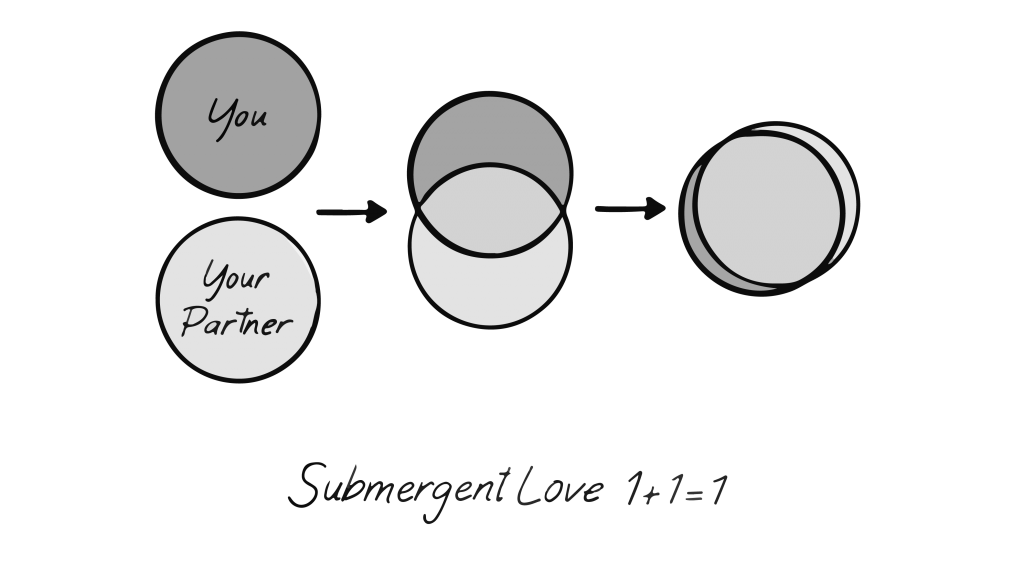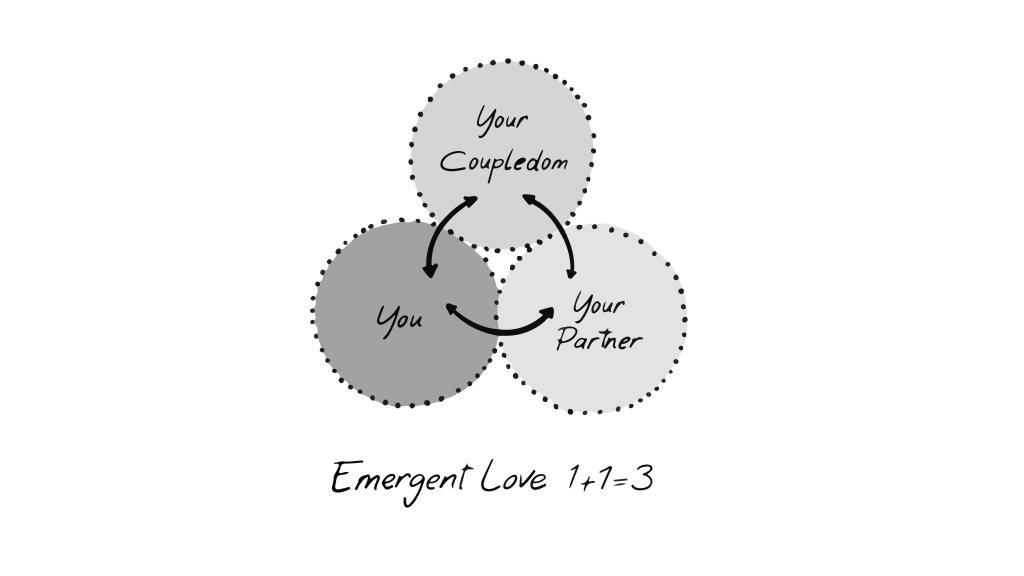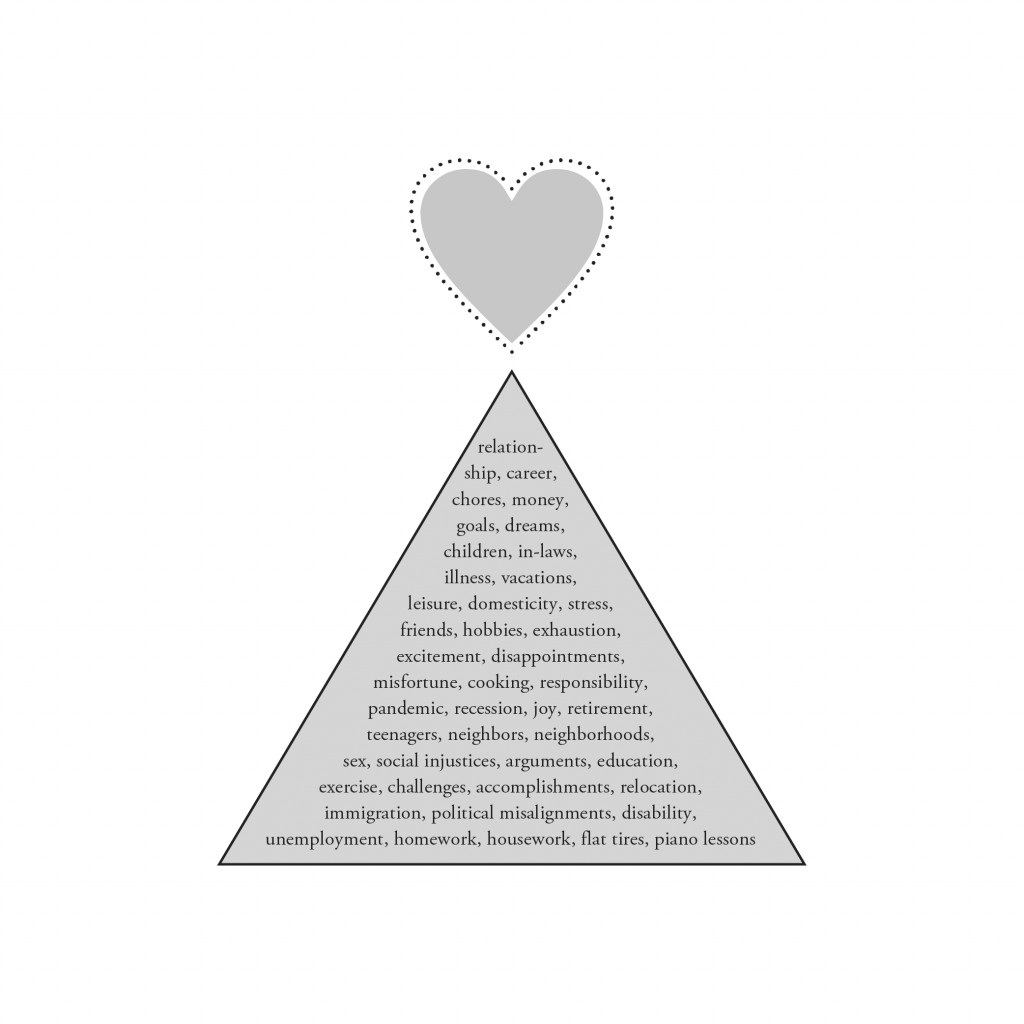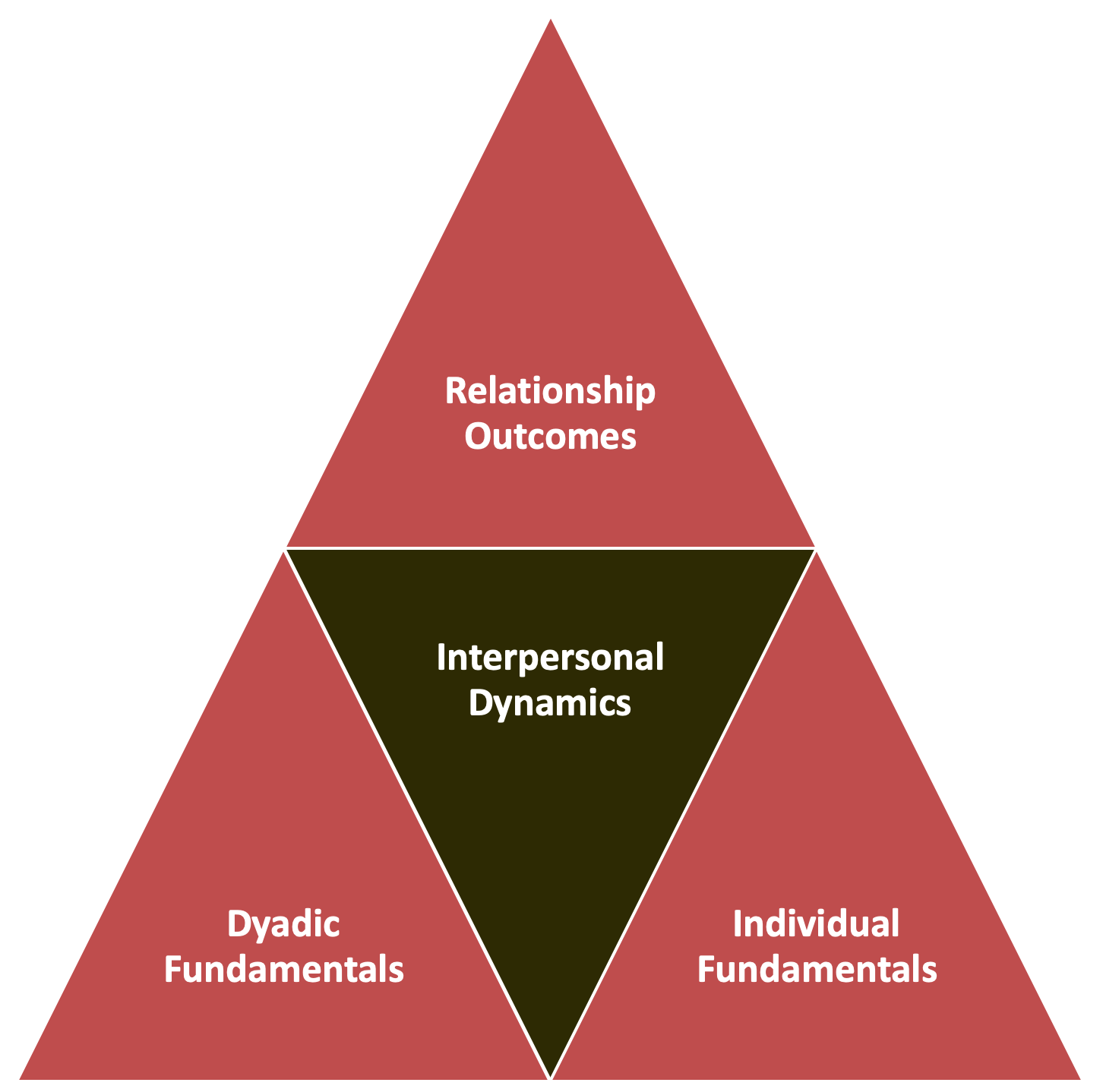What is Emergent Love?
Introducing Emergent Love
An Antidote to Love Confusion

Our current understanding of love produces relationships that are mostly insecure and unsatisfactory. The divorce rate remains at about 50% and this does not include the number of heartbreaks and people who report being traumatized after being in dysfunctional relationships. For the past two decades, I have worked with hundreds of couples across 40 countries and accompanied them on their love journey which sometimes encompasses pain and heartbreak. This pain that these folks have experienced and I have observed has shaped my career path. I aspire to help people experience true love. I genuinely believe that everyone deserves to be, and is capable of having a loving relationship. So what gets on the way?
In this piece, I offer a solution to this very important question with the findings from two critical pieces of my research. The first was a retrospective qualitative study of 312 couples that I have worked with over a 10-year period. I designed this study to assess the way we perceive love – and the problems that may manifest through this perception. I also looked at the progression of these relationships overtime, the type of love experienced and expressed by these couples, and what made it strong and fulfilling. The result was the birth of the Emergent Love Model and its key components.
Understanding how we perceive love allowed the problem to be defined, yet a tangible tool was needed that could help couples obtain an overview of their relationship and identify cracks that needed attention before they drift apart to the point of no return.
A quantitative research study with 159 couples and 345 individuals in participation (US representative sample) led to the creation of a validated inventory called the Relationship Panoramic (RP). RP is used by relationship specialists to help individuals and couples create thriving relationships and a foundation from which long lasting love can emerge.
How do we Currently Understand Love?
There exists a pervasive notion in our society that if two people love each other they can conquer the world, all will be well, and everything will just fall into place. How many times you heard the phrase ‘Love is all you need’? Love is perceived as the foundation of any relationship, and any flaws can be overcome with its magical power. Having a secure and loving bond with a significant other could offer many benefits including social and health welfare; however, the type of love that we talk about in romantic relationships seem to be far from that.
And what is the nature of this love?

Erich Fromm suggests that love cannot just be a feeling and rather it must be a decision. He questions the instability of a feeling versus a conscious choice of a person and how that manifest in the person’s life. But, how closely does our society adhere to Fromm’s suggestion?
There are several definitions and forms of love. For example, in the classic Greek texts and the mystic and Buddhist teachings. The most well-known ones are: Eros or erotic love; Philia or affectionate love; storge or familiar love; ludus or playful love; mania or obsessive love; pragma or enduring love, philautia or self-love and agape or selfless love. As you can observe, we all might experience one form of these or the other with different people in our lives and even with the same people over time. In my work, I get to see how these different definitions of love are understood by real life individuals who perceive themselves to be in love or out of it.
When I ask my couples what they mean by referring to ‘loving’ their partners, or being in love with them, they are often perplexed. At best, they give an amalgamate of all of the above to describe their feelings. You can only imagine the confusion that it creates for themselves and their partners. I came to observe that love in our society can be a scapegoat, an excuse, confusing, over-rated, misunderstood and undernourished.

One of the most common phrases I hear is ‘I just don’t get butterflies anymore’. There is an idea that true love should make you feel this way – excited and nervous. When this feeling is not present or lost, we often feel that the love in the coupledom has vanished and is non-existent.
Another common perception is that love makes you feel ‘out of this world’ – like you are soaring without your feet on the ground. I often ask clients to choose a picture which represents their idea of a romantic relationship, or their hope of how a romantic relationship ought to be. One of my couples, John and Mary, selected a picture of two astronauts, hand in hand, with a heart shape around them. They stated that this image represented their relationship when it first began – feeling as though their feet were not on the ground with a ‘love bubble’ protecting them. They didn’t care where they were going, as long as they were hand in hand together. The idea that love sustains and protects our romantic relationships is very powerful within our social psyche. Simultaneously, love is also expected to feel like an ‘out of this world experience’.
Similarly, there is the well-known notion that ‘love is blind’. Character flaws and better put incompatibilities in the relationship ought not matter when one is in love. In fact, one is expected to either not notice any flaws, or actively overlook them should they become apparent. Being unable to accomplish either of these feats may be interpreted as ‘not really being in love’, or ‘not loving someone enough’.

Finally, it is important to note that there also exists a very fixed understanding of the material progression of a romantic relationship. First, two people meet, expected to spend a lot of time together and fall in love. At this point, the couple is expected to have high preoccupation with one another, they should be spending all their time together and they become ‘one soul in two bodies’. This is what I call a Submergent love. Then, they (culture permitting) move in together. The most recent polls indicate that this linear progression towards marriage remains overwhelmingly powerful, both in practice and ideology.
What are the problems with this model?
The problem with our current model of love is that it seems to produce more heartbreaks than lasting healthy relationships. Let’s look more closely at some of the specific downfalls of some of the points outlined above.
Consider the idea that once you have stopped feeling ‘butterflies’ when you interact with your partner, you have somehow fallen out of love. This notion is, at best, unrealistic and, at worst, promotes an unhealthy ideal for romantic relationships. Dr. Helen Fisher calls the feeling of butterflies in early stages of a connection the ‘infatuation phase’. Crucially, her research finds that this phase lasts on average two years. Staying in that high is neither possible nor healthy for any individual (even physiologically speaking). It also seems impossible to maintain this type of love in a long-term relationship, which will inevitably lead to disappointment and dissatisfaction. Furthermore, scientists Drs. Amir Levine and Rachel Heller, in their book ‘Attached’, note that if a person gives you butterflies, it means they have triggered your nervous system. This is different from feeling sexual attraction for someone. This could be a sign of excitement at the beginning, but this also could mean this person is, in fact, not a good match for you if you desire a stable, long term relationship.
Consider also the idea that love should make you feel ‘out of this world’. This feeling must also end as two people become settled in a relationship and their feet will hit the ground once more. This experience can often be accompanied by great sadness and distress for couples. For them, it can feel like they have fallen out of love once this ‘high’ dissipates, leading to friction and distance. For example, John and Mary reported that as soon as they felt their feet on the ground they started drifting apart. They didn’t have many interests in common and they didn’t share a united vision for their coupledom.
The idea that ‘love is blind’ has truth in it as this can occur in the infatuation phase. During the early, exciting phase of a relationship, when you are infatuated by a person, it becomes easy to ignore, or not notice, flaws and warnings. However, when this phase ends this becomes harder. Incompatibilities, that were once manageable in the face of ‘love’, become impossible to ignore and often become major issues in the relationship.
Finally, we must consider the impact of having such prescriptive notions of the way in which a romantic relationship is ‘suppose to’ progress. Love must be followed by marriage – which must last forever. The status quo often comes with particularly gendered understandings of love, where women must be beacons of emotional expression, and men must be strong, stable, and emotionless. Naturally, this produces pressures and tensions in heterosexual relationships and also has implications for non-heterosexual relationships. This prescribed sort of relationship may not be ideal for many couples. There is little to no freedom to have a relationship which does not meet this stereotype.
Underlying the above point may encompass an opposing dynamic. On the one hand, we expect love to be exciting and tantalizing. On the other hand, we expect loving relationships to be stable and follow a predictable trajectory. This seems to be an insurmountable contradiction.
There is an enormous amount of pressure to have relationships which conform to such an understanding of love – as a result, people often worry about presenting their relationships in a particular way. This behavior is exacerbated by social media, where it is easy to present a relationship in a way which is entirely different from its reality. Some couples report that projecting the relationship they think they should be having onto social media fills the void they feel inside their actual relationship. I have clients who post loving and intimate pictures of themselves on their social media profile to ‘keep the competition away’, or to leave traces of a happy relationship behind for their children. Often, this presents a huge dilemma for some couples when they want to change their relationship agreement. In a way, they have to admit that they were living a pretense.
So, what is the overall understanding of love?
The Submergent Model of Love
If we look closely at the way we present love, we can see that love is presented as the foundation of all romantic relationships. Love is perceived as the most important aspect of a relationship, upon which all other aspects depend. Everything rests upon a version of love which lasts on average two years. So, a fragile sort of love is placed at the base of the relationship, upon which enormous, important aspects are expected to rely. It can be perceived as an inverted pyramid, where love is the unbalanced base, bound to collapse under the pressure. In this way, this model of love can be understood as the Submergent Love Model. Love is trapped at the bottom, and all other factors in the relationship are expected to emerge from this love.

It is clear that this is not a sustainable model. In my research, I have observed three possible outcomes in relationships that followed this model.
First, couples may stay together trapped in the tip of the pyramid, unable to break free from this notion of love. They are often called ‘enmeshed’ in couples’ therapy. This results in depressed, unhappy relationships. These are the couples that would not fight that often – they finish each other’s sentences and, when asked what their hobbies are, look at the other person to fill in the answer. There is a high level of assumption, and autonomy is almost nonexistent. The most common report is of loss of sexual desire – there is usually limited sexual activity. Panic attacks may also be common.
Second, couples may be unable to break out of this unhealthy and consuming bond to define healthy boundaries in relation to their partner. They remain confused about their role in their relationship and feel that they are in constant tension of what they are expected to do and how much they can offer (many of this manifests in their arguments over daily chores and the unfair balance of it from each of their perspectives). Unable to remain unsatisfied in this way they will usually go down two routs: one, look outside for external reprieve to “find themselves”, “to feel alive and wanted again” and “to feel enough”. Two, they just break free from the bond all together just to escape the tension and pain. These couples rarely make it to our offices as a unit, in fact, they usually come in after affair or separation.
Third, there are couples that, mostly by external help – for example, therapy, retreat, reading books, and committing themselves to the growth of their relationship – have broken out of the submergent love. However, there is often significant distance between these individuals, as they are unsure how to be an individual and also give enough to contribute to a thriving relationship. Because now that person is becoming themselves again, having regained the part of themselves which was lost whilst trapped in the Submergent Love Model. With work, it is possible for these couples to form a healthy, satisfying and thriving relationship. These couples present ready to do the work, sometimes exhausted but willing to give it another shot.
Introducing a new paradigm of love will provide the couples with a vision to follow not a preset path that was paved by unquestioned status quo.
The Emergent Love Model
 The data from my retrospective study revealed five, non-negotiable ingredients, indispensable to a thriving relationship. These were: mutual respect, compatibility, physical attraction, compassion/empathy and shared vision. I called them ingredients because, while certain ingredients are needed to a dish, we can choose the quality and quantity of each ingredient based on our taste in that cross-section of time. Thus, these ingredients can be tailored to specific couples. Making this dish must be consistent, continuous, and completely intentional, every step of the way. These are aspects of a relationship that require work and dedication.
The data from my retrospective study revealed five, non-negotiable ingredients, indispensable to a thriving relationship. These were: mutual respect, compatibility, physical attraction, compassion/empathy and shared vision. I called them ingredients because, while certain ingredients are needed to a dish, we can choose the quality and quantity of each ingredient based on our taste in that cross-section of time. Thus, these ingredients can be tailored to specific couples. Making this dish must be consistent, continuous, and completely intentional, every step of the way. These are aspects of a relationship that require work and dedication.

It is from this recipe that love emerges. Rather than being the fragile foundation upon which relationships must rely, love, in the Emergent Love Model, manifests as a by-product of the above ingredients. Imagine a pyramid with the five ingredients as a foundation, and love resting upon them – stable and secure. I see that many couples have a process of working on their relationship; however, if the content that they are working on is not going to serve the overall outcome of the relationship, they often find themselves in an exhausting situation. Knowing the critical ingredients for a thriving relationship would help with the focus of these efforts.
Putting the Ingredients into Research
By this stage, I knew that five key ingredients were needed for the emergence of love in coupledom. However, it still concerned me that the majority of couples who made their way to therapists were on the verge of breaking up. I wanted to see if we can recognize the potential issues before they become unresolvable. In a way, any relationship has cracks that, if left unattended, become chasms. By the time we see couples, they usually, like Mary and John, feel a “world apart”. This contributes to couples’ therapy not being as successful as it has the possibility to be. I needed a tool to be able to assess a coupledom. A tool that would help me explain to my couples about their relationship – highlight the cracks, and areas of strength that they could utilize to mend these cracks, as their relationship evolves over time.
This motivated the second wave of research. In collaboration with Dr. Azarmina, the founder of Thinkocrats, we sat to further validate this model and to add other scales and measures to broaden our perspective toward coupledom. This study included 159 couples with a 10-year average in their relationships (the longest was 42). The result was the creation of an inventory called the Relationship Panoramic Inventory with 12 validated scales and measures. There are three major differences between this test and others out there: 1) It is inclusive of all gender, sexual and relationship orientations, 2) it is scientifically validated, and 3) it assesses couples across critical domains such as thinking style, temperament, childhood experiences and others which are not included in any other tests. This panoramic view will offer a holistic assessment of the coupledom regardless of what seems to be an issue in any given time.

Couples who take the test will learn about 4 main domains:
- Individual fundamentals that they need to bring to the relationship: ability to connect, moral values, healthy financial attitude, positive emotions, positive thoughts, abstract thinking.
- Dyadic fundamentals: mutual physical attraction, shared vision, shared moral values, shared healthy financial attitude.
- Interpersonal dynamics: mutual respect, compassion, loving and being loved, commitment, and trust.
- Relationship outcomes: fit, global satisfaction, sense of thriving, sexual satisfaction, health and well-being.
To Conclude, I strongly believe that an ‘Emergent Love Model’ can provide a framework for thriving and satisfying relationships and offer an antidote to our love confusion. It is possible to be successfully in love and create a thriving relationship over time. We just need to see love with a new lens. As Einstein said: “we cannot solve a problem with the same frame of mind that created it”.
Submergent and Emergent Love Artwork by Gio Castro.


I like the positive approach to a very difficult and complicated area.
This will help many people with relationships crisis.
Thanks
Hi Ruben,
Feel free to listen to this podcast on the model for more details and on how to use it in your everyday life. https://podcasts.apple.com/ca/podcast/a-new-paradigm-for-love/id1352546554?i=1000544184976
Hi Dr. Nasserzadeh, I am a trauma therapist who applies the emergent love concept to therapeutic relational love. Here is an article I wrote in which you are credited. Thank you for the work you do https://open.substack.com/pub/melindazappone/p/the-emergent-love-model-of-therapy?r=3awo6w&utm_campaign=post&utm_medium=web&showWelcomeOnShare=true
Dear Melinda, thank you for sharing your work with us here. it is heartwarming to know that the Emergent Love Model has resonated with you and you could adopt it to provide a framework for therapeutic work.